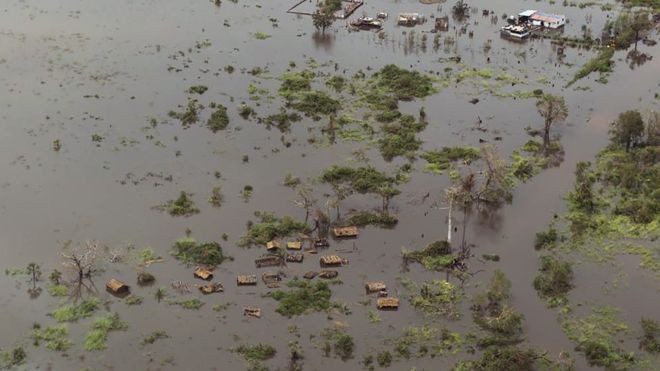
ZIMBABWE, like many other countries, is vulnerable to a range of natural disasters, including floods, droughts and cyclones. In recent years, the country has recognised the potential of digital technologies in enhancing disaster response and mitigation efforts.
From early warning systems to mobile applications and crowdsourcing platforms, digital technologies have emerged as powerful tools to improve preparedness, response and recovery in Zimbabwe.
Digital technologies have greatly improved early warning systems in Zimbabwe, enabling authorities to provide timely alerts and vital information to communities at risk. The Meteorological Services Department of Zimbabwe, for instance, has implemented automated weather stations that collect real-time data on weather conditions.
This data is then analysed to generate accurate and timely forecasts, which are disseminated through various channels, including radio, television and SMS alerts. By leveraging on digital technologies, early warning systems can reach remote and vulnerable communities, enabling them to take proactive measures and evacuate if necessary.
Additionally, mobile applications can provide localised weather information and alerts, ensuring that individuals have access to critical information on their smartphones.
Mobile applications for disaster preparedness
Mobile applications have become valuable tools for disaster preparedness in Zimbabwe. For instance, the Zimbabwe Red Cross Society has developed the disaster preparedness app that provides users with information on disaster risks, safety tips, and emergency contact numbers.
The app also includes a feature for users to report incidents and request assistance during disasters. Similarly, the Zimbabwe National Water Authority has launched the Water Crisis App to help monitor and manage water resources during droughts.
- Mavhunga puts DeMbare into Chibuku quarterfinals
- Bulls to charge into Zimbabwe gold stocks
- Ndiraya concerned as goals dry up
- Letters: How solar power is transforming African farms
Keep Reading
A number of countries in Africa have embraced the use of digital technologies including Rwanda, South Africa, Ghana and Ethiopia to name a few.
Rwanda has been proactive in adopting digital technologies for disaster management. The country utilises the Rwanda Emergency Medical Services platform, which integrates mobile technology and GPS tracking to enhance emergency response and medical services during disasters. South Africa has integrated digital technologies into its disaster management strategies.
The South African Weather Services uses digital platforms to disseminate weather forecasts, severe weather warnings and alerts to the public. The country also employs mobile applications and online platforms for information sharing and co-ordination during emergencies.
Ghana has embraced digital technologies in disaster management. The country’s National Disaster Management Organisation employs mobile applications and online platforms for information dissemination, coordination and reporting of incidents during emergencies.
Ethiopia has made efforts to integrate digital technologies into disaster response and mitigation.
The country has implemented the rapid emergency assessment and co-ordination tool, which is a mobile-based platform used for collecting, analysing and sharing data during emergencies. It is important to note that while these countries have adopted digital technologies in disaster management, the extent of implementation may vary among different regions and organisations within each country.
This app enables users to report water-related issues, track water availability and receive updates on water rationing schedules. These mobile applications empower individuals to be better prepared for disasters, fostering community resilience.
Crowdsourcing and social media platforms have played a significant role in disaster response and mitigation in Zimbabwe. In times of crisis, citizens turn to platforms like X (formerly Twitter) and Facebook to share real-time information, request help, and provide updates on the situation on the ground.
These platforms enable authorities and relief organisations to gather critical information, identify areas of need, and co-ordinate response efforts. For example, during the Cyclone Idai disaster in 2019, social media platforms served as vital communication channels for disseminating information, organising relief efforts, and mobilising resources.
Crowdsourcing platforms, such as Ushahidi, have also been utilised to map affected areas, track incidents and co-ordinate volunteer efforts.
The power of crowdsourcing and social media allows for rapid information dissemination, efficient resource mobilisation, and community engagement, strengthening disaster response and recovery.
Remote sensing and GIS Mapping digital technologies such as remote sensing and geographic information systems (GIS) have revolutionised data collection and mapping in disaster-prone areas of Zimbabwe.
Satellite imagery and remote sensing technologies provide high-resolution data that can be used to assess the extent of damage, identify hazard-prone areas and plan response strategies.
Organisations like the United Nations Office for the Co-ordination of Humanitarian Affairs utilise GIS mapping to visualise and analyse data on affected populations, infrastructure and resources.
This information aids in decision-making, resource allocation and co-ordination of relief efforts.
Additionally, drones equipped with cameras and sensors have been used to capture real-time imagery, conduct damage assessments and survey inaccessible areas, enabling a more comprehensive understanding of the disaster’s impact.
While digital technologies offer immense potential in disaster management, Zimbabwe faces several challenges in their effective implementation. Limited access to reliable internet connectivity and technological infrastructure gaps pose barriers to the widespread adoption of digital technologies, particularly in rural areas.
Addressing these challenges requires investment in infrastructural development and efforts to bridge the digital divide. Additionally, ensuring data privacy and security is crucial, as the collection and storage of sensitive information during disasters can be at risk.
Looking to the future, Zimbabwe can further harness digital technologies through advancements in artificial intelligence, machine learning and data analytics.
Predictive modelling can help anticipate the long-term impacts of disasters, informing resilience strategies and resource planning. The integration of internet of things devices with early warning systems can provide real-time data from multiple sources, enhancing situational awareness.
Furthermore, partnerships between government agencies, humanitarian organisations and the private sector can foster innovation and collaboration in leveraging on digital technologies for disaster management.
Digital technologies have the potential to transform disaster response and mitigation in Zimbabwe. Early warning systems, mobile applications, crowdsourcing platforms, remote sensing and GIS mapping are invaluable tools that enhance preparedness, response and recovery efforts.
Overcoming challenges related to access, infrastructure and data security is crucial to ensure equitable deployment of digital technologies. By leveraging on the power of digital innovation and fostering collaboration between stakeholders, Zimbabwe can build more resilient communities and improve its ability to respond to and mitigate the impacts of natural disasters.
The continued exploration and integration of emerging technologies will further enhance Zimbabwe’s disaster management capabilities, ultimately saving lives and minimising the devastating effects of disasters in the country.
- Gary Gerald Mtombeni is a journalist based in Harare. He writes here in his own personal capacity. For feedback Email garymtombeni@gmail.com/ call- +263778861608.










